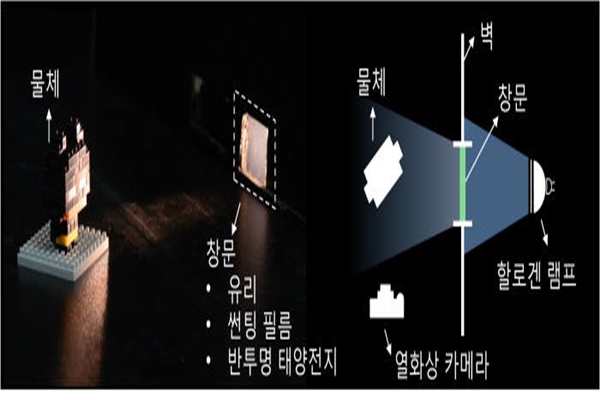Semi-transparent solar battery technology that can produce electricity while blocking heat at the same time is developed. By using multi-layered metallic thin-film-based transparent electrodes, it allows visible ray to penetrate and reflects infrared light selectively and produces electricity during this process. Because it can maintain low indoor temperature while using energy efficiently, it is expected to be used for variety of purposes such as car window tinting and windows and doors of buildings.
KAIST (Chancellor Kang Seung-mo) made announcement on the 1st that a research team led by Professor Yoo Seung-hyeop of Electric and Electronic Engineering Department of KAIST and Professor Park Nam-kyu of Chemical Engineering Department of Seonggyungwan University has developed such semi-transparent solar battery technology and its research was published as the cover thesis for Advanced Energy Materials on the 20th of last month.
Because solar batteries absorb light and produce electricity, semi-transparent characteristic that allows light to penetrate can only reduce efficiency. Also it is difficult to manufacture current crystalline silicon-based solar batteries as semi-transparent batteries.
Research team had used perovskite, which is made up of organic and inorganic compounds and is seen as the solar battery material for next generations, as a photoelectric transformation material and has implemented semi-transparent solar batteries by using transparent electrodes on both sides.

One of the transparent electrodes uses metal-based multi-layer thin film with a structure of ‘insulation shield-metal-insulation shield’, which was used by this research team on electronic elements for many years.
Research team has implemented transparent electrodes by manufacturing metals that do not allow almost any penetration of light as thin films with thickness of tens of nanometers and laminating insulation shield that has high refractive index and lowers reflection on top.
Transparent electrodes are designed so that they allow penetration of visible spectrum by having precise thickness of each layer and reflect invisible spectrum. Through this design, it was able to manufacture semi-transparent solar batteries with penetration rate for visible rays at an average of 7.4%, which is similar to films that are used to tint cars, and photoelectric transformation efficiency of 13.3%.
Research team added a function that effectively reflects heat ray from solar energy by maximizing reflection of infrared light. Because temperature of tint films increases when they are exposed to light since they block off heat by absorbing it, temperature of this newly-developed solar batteries almost does not increase.
“Semi-transparent solar batteries with an ability to block off heat are manufactured as film-type batteries that are able to adjust colors through additional optical design and can be used for cars or windows of buildings.” said Professor Yoo. “If solar batteries add more new values like this, they will be able to pioneer even bigger markets.”
Staff Reporter Kim, Soonki | soonkkim@etnews.com